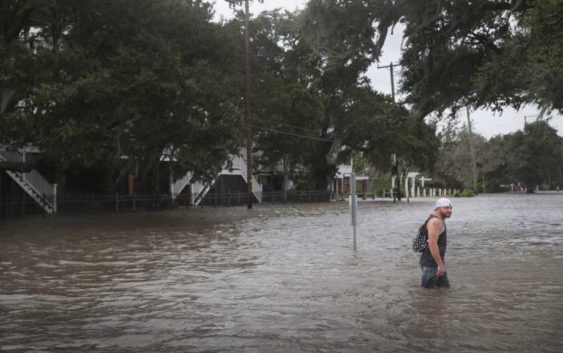'Don’t let your guard down': Officials say flooding concerns remain as Barry pushes inland

Weakened but still potent, Barry inundated the Gulf Coast but appeared unlikely to deluge New Orleans as it continued its slow advance.
Still, Gov. John Bel Edwards on Saturday night urged residents across south Louisiana to stay “vigilant,” warning that Barry could still cause disastrous flooding across a wide stretch of the Gulf Coast.
“This storm still has a long way to go before it leaves this state,” Edwards said. “Don’t let your guard down.”
New Orleans had been braced for heavy rains Saturday, but instead had intermittent bands of moderate showers and occasional sunshine.
The storm was briefly upgraded to a Category 1 hurricane Saturday morning before it quickly weakened to a tropical storm when it made landfall near Intracoastal City, Louisiana, later in the afternoon.
In St. Mary Parish, about 60 miles east of where Barry made landfall, 64-year-old Joyce Webber and about 20 others huddled inside the Baldwin Community Center to take refuge from the storm. Some of them relaxed on cots, paging through books, while parents tried to keep their children entertained.
Webber, a cook at a Cajun restaurant, had just found out a large tree branch had fallen on her mobile home and her storm door had blown off.
“Trailers don’t hold, no matter what type of storm,” she told CNN. “They just don’t hold.”
But she could see the silver lining. “It’s good to see your neighbors here,” Webber said. “The blessing is coming together. It feels like a family in times like these.”
Though Barry will continue to dump rain throughout the weekend, forecasters downgraded rainfall estimates for the city through Sunday to between 2 to 4 inches. Forecasters had earlier said New Orleans could get up to 20 inches of rain, raising concerns that water pumps strengthened after Hurricane Katrina would be overwhelmed.
As of Sunday morning, over 70,000 power outages were reported in Louisiana.
The National Hurricane Center said in its 11 a.m. advisory Sunday that Barry had weakened to winds of 40 mph, and the storm’s center was located about 50 miles south-southeast of Shreveport. It was moving north at 9 mph.
Maximum sustained winds are near 45 mph with higher gusts.
The system’s sluggish progression and more westward track was especially good news for the Mississippi River. The National Weather Service said the river is now projected to crest at 17.1 feet — almost 2 feet below the previously projected 19 feet. Flood stage is 17 feet.
National Weather Service forecaster Robert Ricks cautioned, however, that it was too early to say for certain that New Orleans was in the clear. “We’re about at the (halfway) mark of the marathon right now,” he said Saturday evening. Heavy rainfall from the storm would be concentrated overnight in a wide area centered around Lafayette, he said. The city is about 120 miles west of New Orleans.
During a news conference Saturday night, Edwards said that even though the Tropical Storm Barry’s winds may have weakened, the threat of rain is significant.
The Democratic governor says he spoke to President Donald Trump on the phone Saturday. He says Trump told him he was “pulling for” Louisiana and would ensure the state receives necessary aid.
Trump on Thursday declared a state of emergency ahead of Barry’s anticipated landfall. The declaration authorizes the Department of Homeland Security and Federal Emergency Management Agency to coordinate all disaster relief efforts.
Edwards had asked the Trump administration in a letter earlier Thursday that the state receive supplementary federal resources as soon as possible, should they be needed.
The Associated Press and CNN contributed to this report.